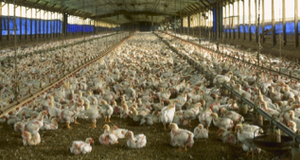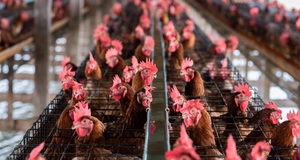From Discussions VOL. 10 NO. 3A New Approach to Ohio Pig FarmingFuture StepsDespite evidence of alternative pig farming’s ability to take the place of conventional methods, alternative approaches are struggling to become mainstream. These limiting factors involve intensive labor and a tendency to focus less on efficiency and more on quality. Alternative farming methods can be less appealing to the farmer because there is a high amount of involvement and labor that goes into raising the animals, as expressed by Brown and Boehnlein. In many ways, this is an inevitable part of this farming approach. However, there are still aspects of the conventional business model that can be used in alternative farming without reverting to harmful methods. Besides the mechanization of feed and water and the confinement of herds indoors, one way that conventional farming makes their labor more efficient is through contracting. Kenneth Oberholtzer owns a breeding farm in Ashland and is on contract with Hord Livestock Co. Compared to when he owned a conventional farm independently, Oberholtzer notes that now he experiences little risk from market variability and is allowed to focus on the aspects of pig farming that he enjoys most. Without having to worry about dealing with feed orders, drug companies, and hedging the price of his pigs, “the only thing that I concentrate on anymore is producing pigs, which is really the thing I like to do, it’s the thing I understand how to do, it’s probably the thing that I’m best at doing,” said Oberholtzer (Kenneth Oberholtzer, personal communication, March 15, 2014). Allowing for a higher division of labor in the alternative method with a more complex business structure would create a model that is easier to support and spread throughout Ohio. The conventional model of pig farming adds components to a system that would otherwise be simple and efficient by design. While the nutrient cycle for pastureraised hogs is in many ways a self-contained system that can virtually continue until the sun fails, conventional methods involve outside inputs and wasted resources (Figure 1). In the same way that the FDA has begun to phase out the use of antibiotics, it would be prudent to make steps in the direction of limiting these inputs so that pig farming can improve in this aspect of efficiency. It is evident that sustainability and high productivity do not have to live under different roofs. However, modern alternative farms may not always be as focused on a culture of efficiency as farms run by conventional methods. Although often resourceful in their methods, Brown and Boehnlein are less focused on high productivity. Neither expressed extreme interest in increasing the size of their farms or striving to produce more per acre. Oberholtzer and Hord, however, both spoke of efficiency as their driven goal, something they strive for on a daily basis, with Oberholtzer priding himself on running a farm that is more efficient than 95 percent of other farms (Kenneth Oberholtzer, personal communication, March 15, 2014). From the small-scale farmer’s perspective, however, there is value in realizing the sustainable limits of the land on which the animals are raised. The government provides subsidies for corn and soybean crops, a large portion of which is used for livestock feed. If some of this money was reallocated to supporting alternative methods of pig farming, it could encourage this sector’s development. For example, one aspect of infrastructure that alternative methods are currently struggling with is butchering. The consolidation of the pork industry drove many smaller, niche slaughterhouses out of business. Now, although the movement towards smallscale pig farming is growing, many farmers, including farm owners Brown and Boehnlein, still have difficulty finding slaughterhouses that do not operate at the industrial level and provide the humane, stress-free butchering that many consumers prefer. Brown has gone through four different butchers in order to find one that would consistently produce the specific cuts required by customers, and now has to travel close to two hours to get to the butcher (Katie Brown, personal communication, March 30, 2014). Boehnlein must travel several hours to Columbus, Ohio to reach her butcher (Kristen Boehnlein, personal communication, April 12, 2014) With a stronger infrastructure, the development of contract farming and the increased number of small-scale, humane butchering companies would aid the growth of alternative methods in Ohio. Ohio: A Leader in the World of Pig FarmingIt is time to collectively concern ourselves with the current production of pork. The largest pork production corporation in the world, Smithfield Foods, is located only a couple states away in Virginia. Shuanghui International Holdings Ltd., a large Chinese pork producer, recently bought this corporation. Figure 1. Conceptual nutrient cycles of conventional pig farming (left) and alternative methods, specifically pasture-raised pigs (right). This means major growth for Smithfield despite the U.S.’s fairly stagnant pork market, creating more large-scale conventional farms (Felberbaum 2013). Lying within this industry are critical issues that are changing as we speak, and action can be taken now. Ohio invented conventional pork production, and we can choose to be the first to reform it. By taking the appropriate steps, this state can be at the forefront of a movement towards better forms of pig farming. AuthorHannah Bidigare-Curtis graduated from Granville High School in central Ohio and is going into her fourth year at CWRU as a Biology and Environmental Studies Major. She is currently an executive member of CWRU’s Student Sustainability Council and has participated in various school programs such as CCEL Scholars. Hannah has previously grown produce to sell at her hometown’s farmers market and presently works at the University Farm. She hopes to be involved in agriculture in the future. AcknowledgementsI would like to thank Mary Holmes for guidance on this project and to Kenneth Oberholtzer, Kristen Boehnlein, Katie Brown, and Pat Hord for taking time out of their days to talk with me and show me their farms. ReferencesBender, M.H. Animal Production And Farm Size In Holmes County, Ohio, And US Agriculture. 2003. American Journal Of Alternative Agriculture 18.2. 70-79. Boehnlein, Kristen. In-person interview. 12 April 2014. Brown, Katie. In-person interview. 30 March 2014. Fang, Hsin-Wei, Po-Hsing Chiang, and Yhu-Chering Huang. Livestock-Associated Methicillin-Resistant Staphylococcus Aureus ST9 In Pigs And Related Personnel In Taiwan. 2014.Plos ONE 9.2. 1-7. Felberbaum, Michael. Chinese Get OK to Buy American Pork Producer - NBC News. 24 Sept. 2013. NBC News. Hord, Pat. Phone interview. 29 March 2014. Imhoff, Dan, ed. The CAFO Reader: The Tragedy of Industrial Animal Factories. Healdsburg, CA: Watershed Media, 2010. Print. Johnson, Nathanael. Swine of the Time: The Making of the Modern Pig. May 2006. Harper’s Magazine. 1-10. Web. Mizelle, Brett. Pig. 2011. London: Reaktion. Print. FOX News. New Pig Virus Found in Ohio. 13 Feb. 2014. Fox News. FOX News Network. Nilzen, V., J. Babol, P.C. Dutta, N. Lundeheim, A-C. Enfalt, K. Lundstrom. Free range rearing of pigs with access to pasture grazingeffect on fatty acid compostition and lipid oxidation products. 2001. Meat Science 58. 267-275. NRDC. Pollution from Giant Livestock Farms Threatens Public Health. 21 Feb. 2013. National Resource Defense Council. Oberholtzer, Kenneth. In-person interview. 15 March 2014. Plumer, Brad. The FDA Is Cracking down on Antibiotics on Farms. Here’s What You Should Know. 14 Dec. 2013. Washington Post. The Washington Post. Stith, Pat. The Pulitzer Prizes: Murphy’s Law. 22 Feb 1995. The Pulitzer Prizes. Wegener, Henrik C. Antibiotics in animal feed and their role in resistance development. 2003. Current Opinion in Microbiology 6. 439-445. “Wendell H. Murphy.” 27 Mar. 2012. UNC-TV. Web. Xue, Katherine. Superbug: An epidemic begins. May 2014. Harvard Magazine. 40-49. Print. Zhang, Sarah. Pig-manure Fertilizer Linked to Human MRSA Infections. Sept. 2013. Nature: International Weekly Journal of Science. Nature Publishing Group. Suggested Reading from Inquiries Journal
Inquiries Journal provides undergraduate and graduate students around the world a platform for the wide dissemination of academic work over a range of core disciplines. Representing the work of students from hundreds of institutions around the globe, Inquiries Journal's large database of academic articles is completely free. Learn more | Blog | Submit Latest in Environmental Studies |




















